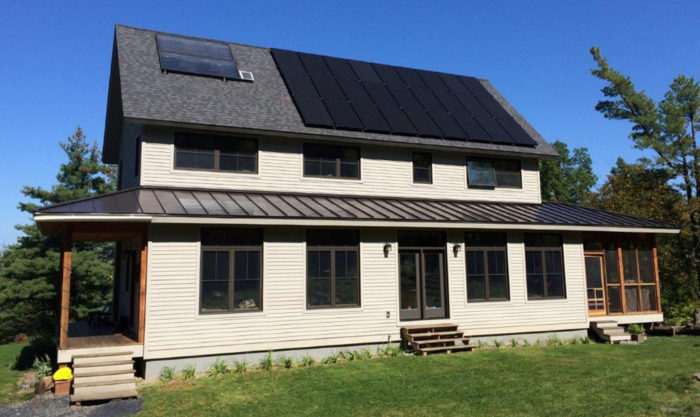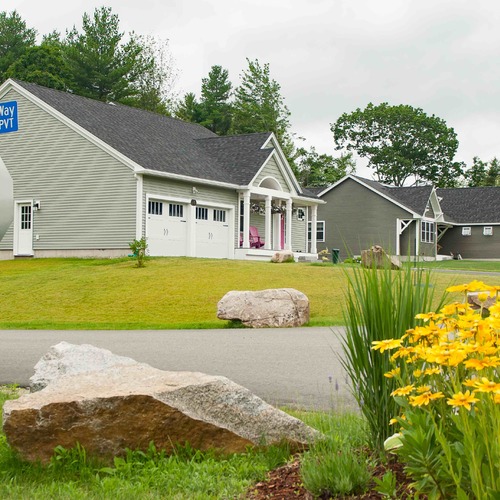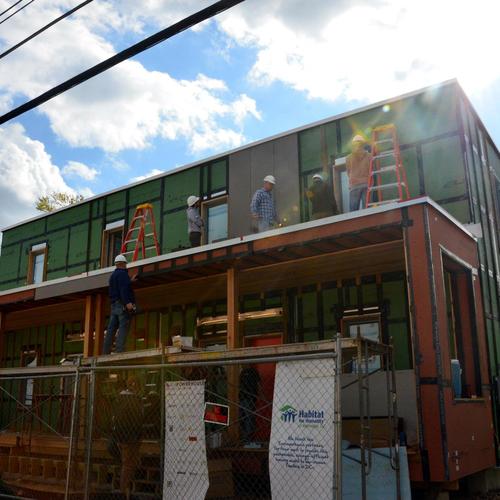
Image Credit: William Kallock
At Green Building Advisor, we urge readers who are planning to build a new home to seek out a builder who understands energy-efficient construction methods. Is this advice easy to follow? And once the new owners move into their energy-efficient home, are they happy with the home’s performance?
Answers to these questions were provided recently at a conference presentation by Matt Sargent, a senior building energy consultant at Efficiency Vermont, and William Kallock, a vice president at Integral Analytics. Sargeant and Kallock gave their presentation on February 7, 2018, at the Better Buildings By Design conference in Burlington, Vermont.
Researchers interviewed owners of high-performance homes
Sargent reported the results of research project that included interviews with 11 owners of recently completed high-performance homes in Vermont.
From the perspective of Efficiency Vermont, a nonprofit “efficiency utility” that provides financial incentives for energy-efficiency improvements by homeowners, builders, and businesses in Vermont, the term “high-performance home” has a specific definition. To be certified under Efficiency Vermont’s “High-Performance Home” program, a new home has to meet specific prescriptive requirements. (For more information on Efficiency Vermont’s “High-Performance Home” program, see Three Superinsulated Houses in Vermont.)
Sargent told the Burlington audience, “The program assumes that these will be all-electric homes heated by a heat pump, so we need envelope specs that are good enough for point-source heating.” The criteria were developed for the Vermont climate.
Sargent continued, “We needed feedback for the program and the contractors. Researchers wanted to know, who are these homeowners — the owners of high-performance homes? What was the construction experience like? What’s it like living in this type of home? To get answers, we conducted kitchen-table chats with 11 homeowners. Each interview lasted between one and two hours.”
Weekly Newsletter
Get building science and energy efficiency advice, plus special offers, in your inbox.

This article is only available to GBA Prime Members
Sign up for a free trial and get instant access to this article as well as GBA’s complete library of premium articles and construction details.
Start Free TrialAlready a member? Log in














18 Comments
Finding a builder
I completely agree that finding a builder is difficult , but so was finding an architect. My experience so far has been one of confusion, booth on my part and those who I try to hire. To hire "green builders and architects in my area would have driven costs up enough that I don't know if there could have ever been a payoff period, I would have had to just been satisfied with hopefully improving my "footprint". Thankfully this site exists so I can bounce ideas off knowledgeable people and learn enough that I have acted as the G.C. Had a regular architect willing to work with me to do drawings specified by me. I hired a younger contractor to do the framing that is willing to learn and work with me, at no real extra cost, because of his interest in the "green " builds and seeing this may be the way in his future builds. Both parties did have numerous questions, but in the end understood what I was after. Now with foundation starting in weeks hopefully this will all pay off with a house I'm happy with similar to the folks above.
PERSIST or other efficient modulars?
The biggest advantages of modular should come from the controlled building environment and the ability to leverage highly knowledgeable builders on multiple home builds simultaneously. Adding exterior foam after arrival of a modular on site defeats those advantages. Modular home modules are limited in width, roof pitch and overhangs unless other measures are taken that reduce modular advantages, but there are many instances where a high efficiency modular home built within the most efficient limits could meet needs and wants for housing. Would take some innovation to figure out a tight sealing system between modules and the foundation on a PERSIST or other tight and efficient modular home, but the potential for meeting many housing needs looks high. Any GBAers know of a modular company building high efficiency homes, or brave enough to start one up?
This should be a cost effective approach to modular NetZero Homes for zone 4 https://www.youtube.com/watch?v=5ZsUNzNdpPo&t=1358s
Build Smart in Lawrence, Kansas can do the modular for you: https://buildsmartna.com/
Mitchell, this company sells
Mitchell, this company sells fairly high performance modular homes: https://www.brightbuilthome.com/.
This company sells super high performance, panelized homes: https://www.ecocor.us/
Ability to leverage highly knowledgeable builders...
Mitchell hit on an underappreciated advantage of factory-built houses. We are able to have this forum on GBA because we are all using microprocessors designed by giant team of PhD level engineers, fabricated with incredibly tight process control. It's not that Intel's engineers are smarter than building scientists--it's that they get to specialize. And the knowledge of what works well is institutionalized and applied to building every microprocessor. There's no "microchip advisor" website where someone from Kansas writes in and asks how to find someone to grow gate oxide on his wafer and people suggest that he instead rent an oven, and experiment with different temperatures.
Interesting read...I have witnessed most of this first hand
I just finished building our house (flatrock passive) and have had similar experiences. Local builders weren't up to the challenge...So since I have some building experience I did the passive house builders course myself and wrote the certification exam. This is probably not an option for most home owners wishing to build performance homes. This being said, acting as the general wasnt easy. Dealing with trades and contractors that had very little knowledge of insulation and execution of the air sealing details in the plans was a major investiment in my own time. I am confident that we would have never hit 0.29 ACH on our second blower door test if the details had been left in the hands of other people.
It was hard to know the incremental costs...they are substantial and rack up quickly. This was a worry from the start but I was prepared monetarily to deal with those costs. The bank didn't care about the extra costs and my appraisal came in low because the appraiser failed and basically refused to consider that energy upgrades were valuable. So basically, the appraisal was based on uncomparable "comparables".
Our concrete floors are fine. With an interior temperature of 20 C and R40 under the slab I don;t find them to be uncomfortable...my wife has expressed that her feet get tired quickly with the hard floors so we have had to place anti fatigue mats in certain places in the kitchen.
The house is by far the most silent house I have ever lived in. It is quiet beyond belief...it takes about 70 km winds to really know there is anything on the go outside. Even rain clicking against the windows is more muffled than our previous house. I will note that it is eerily quiet on times....so much that you hear "house sounds" more than you ever did before. I am guessing that concrete floors and less ambient noise amplify certain sounds. It is the most comfortable house I have ever lived in. You can sit by the window when its -10 C and there are no drafts from the cold panes and overall you feel the same temperature everywhere. Less thermal bridging and higher mean radiant temperature due to the constant temperatures of surrounding objects plays a huge role in human comfort.
Installing an ERV was a great idea. As expected, the ERV maintains higher indoor humidity in the winter. It is much more comfortable than our previous house. There have been no compaints about dry skin, night time coughing, dry noses, etc since we moved in.
The house is bright, even on cloudy days. The large windows are great and the wide window sills look amazing.
Electric baseboards in the bedrooms and a minisplit would have been a much more cost effective option then my hydronic electric/wood fired system. This being said, I love my hydronic radiators and my wood stove so I wouldn't trade it. However, from a builder point of view, electric baseboards and a minisplit would be a more profitable option and simpler for most home owners.
i have lots more to comment on but have run out of time for now......
Care to share any design details of your hydronic radiant heat distribution system? Working on mine now. Planning to supply space and DHW with combi heat pump, and install radiant floors downstairs, and radiant panels upstairs.
Adam
Adam, we built our house 23 years ago with radiant floor in the slab and a ducted air handler for the second floor. I did the installation with help from my family and it was very affordable. I had the advantage of having taught radiant system design and installation for five years in the 80's and installation experience as a contractor in the 70s. Insulating under the slab (which I wish I had done) and at the edge is critical. Because we can heat and cool using either radiant or forced air, our house was evaluated by Oak Ridge National Lab under a California Energy Commission funded project in 2002. The results were that energy use was a wash. An advantage of floor cooling is that the slab can be pre-cooled at night to avoid running the condensing unit (that I converted to a water chiller) during peak periods. Another is that heating the slab makes the tiled portions of the floor way more comfortable and acceptable. Those exposed surfaces increase interior thermal mass and reduce indoor temperature fluctuations. The reason I didn't use radiant for the second floor was I wanted to install a system we designed that integrates nighttime ventilation cooling and year-round filtered ventilation. Though we have a very efficient condensing water heater that also provides space heating, I'm going to start working on a redesign so I can convert to an air-to-water heat pump to get off natural gas. Wish those had been available 23 years ago. You can contact me at [email protected]. -David
I'm very confused by the
I'm very confused by the almost 3800kWh to heat a CZ6 passive house with a living area of ~2400ft^2. That's about what we used in our CZ6 2400ft^2 house that only has R60 in the attic, "R20" walls with batt insulation, and no insulation under the slab.
In fact I've been increasingly surprised at the varying energy usage of several of the homes that have been discussed here on GBA, both in the comments of the Q&A section, and in the articles. From what I've seen I cant attribute the difference to just family size or house alone. I'm really curious if anyone has preformed a study to show how differences in usage patterns alone affect energy consumption.
Calum...here is a link
Calum, this was posted on GBA some time ago:
https://www.greenbuildingadvisor.com/blogs/dept/guest-blogs/measuring-passive-house-energy-performance
Point # 2 observed by Katrin Klingenberg :"Interestingly, occupants are better than their reputation; they were not major contributors to the performance gaps.
ALthough this may be the case for this limited study, it probably doesn't apply to all homesowners.
Point #5. " Quality assurance and verification are critical to success. The experience of the team members (CPHC, builder, and verifier) and the accuracy and trustworthiness of the tools they have available to them to back-check their assumptions against reality are indispensable to achieving passive levels of performance."
I found this article to be somewhat insightful and provides a view of two models and final energy consumption patterns.
It does go to show that modeling is a great tool and indespensible to our understanding....but these tools do not construct reality....physics does that for us! After which its left to us to figure out what went wrong!
Calum and David
Ms. Kingenberg is right, about the self-selecting group that lives in high-performance houses, but I suspect occupant behaviour is a much larger variable among typical homeowners who have little interest in the subject, or renters who don't pay utilities.
I built a fairly tight and well-insulated house two years ago where the owners leave several quite large windows open all year round, offsetting the energy loss why burning huge amounts of firewood.
Re-reading Martin's blog I wonder if even among occupants of high-performance houses we may being a bit optimistic. One couple is described as keeping their home at 63 degrees. That's got to skew results!
Dave B
I could have written your comment myself, so many parallels. I designed mine and had an architectural draftsman do up plans and mods. Expect to finish it this year and move in. Enjoy your build and I think you will be happy with the results, I am so far. I did 2x6, ply and 4" reclaimed roofing foam with 2" closed cell on interior, 6" on the roof. Even without heat on in winter it is remarkably stable temperature wise with just solar heat.
Details on solar hot water system why "I wouldn't do it again."
It would be helpful to understand why "I wouldn't do it again." what issues were experienced with the solar hot water system?
Return on investment chart
I need this chart explained, please. Especially a tool purported to help address the “valuation challenge “ posed by appraisers unqualified to value green features.
Kevin: return chart
Kevin, that return on investment chart has built in some assumption about the difference in fuel cost between the energy star and passive house designs. I don't see that assumption documented, so I don't think there's a way for the rest of us to use it.
Response to Duane Scaggs (Comment #10)
Duane,
There are three main reasons why solar hot water systems are rarely installed these days. The first reason is that they aren't cost-effective -- meaning that the energy savings attributable to a solar hot water system are too low to justify the high installation cost.
The second reason (related to the first) is that photovoltaic systems are now so cheap that an investment in PV makes more sense than an investment in solar thermal for anyone with a special interest in solar power. For more information on this issue, see Solar Thermal Is Really, Really Dead.
The third reason is that solar hot water systems are mechanically complicated (especially compared to PV systems) and have high maintenance costs.
Response to Kevin Brauer (Comment #11)
Kevin,
Charlie Sullivan is right: If you want to create a chart like the one shared by Bill Kallock, you need to know the annual energy savings associated with the incremental investment in energy features. This requires the use of energy modeling software, and is specific to each project.
For a thorough discussion of these issues, see Payback Calculations for Energy-Efficiency Improvements.
Log in or become a member to post a comment.
Sign up Log in